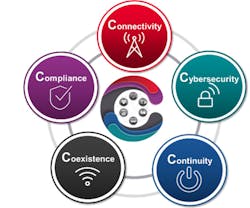This article appeared in Electronic Design and has been published here with permission.
Telehealth is currently under the spotlight because of the COVID-19 pandemic. Doctors and nurses not only need to deal with the usual injuries and illnesses in addition to COVID-19, but also do so remotely in many cases. Cellular communication plays a critical role in the growth of telehealth, providing support for videoconferencing and remote patient monitoring (RPM) plus wireless communications.
These days, the internet of medical things (IoMT) is generating large amounts of information. 5G technology is needed to better address the amounts of information being generated (see figure below). To get a better idea about the latest telehealth trends, I spoke with Ee Huei Sin, vice president and general manager for General Electronics Measurement Solutions at Keysight Technologies.
What are the current technology challenges hospital and healthcare facilities face regarding technology powering remote patient visits?
Telehealth today is limited by the network capacity to manage massive telehealth data. Ultra-reliable, high-speed, wide-bandwidth, and low-latency networks are required to support telehealth.
For example, remote patient monitoring needs to address real-time monitoring as well as streaming and analysis of patient data from massive medical devices. Virtual consultation via high-definition video is also coming and could very well dominate doctor/patient interactions.
Other applications of IoMT include the connected smart ambulance, where real-time streaming of patient data and emergency consultation via video allows remote support of on-site paramedics. Even remote surgery using robot control are being employed. This support along with emergency signal support requires extremely low latency besides real-time streaming on video and patient data.
Hospitals also need secure and efficient health-management systems to handle electronic medical records (EMRs), patient and hospital workflow, and connected devices. This requires a high level of network security and data protection for patient data privacy and security, especially when allowing external mobile access to EMRs.
Does this technology meet current needs for bandwidth, connectivity, security, etc., and what needs to change?
5G technology was designed to support a large amount of connectivity and complex use cases such as telehealth. Enhanced mobile broadband (eMBB) is designed to deliver high bandwidth to support real-time 3D video as well as augmented-reality (AR) and virtual-reality (VR) applications.
5G supports high speeds of up to 20 Gb/s based on IMT-2020 and 1-GHz bandwidth, along with 10,000X greater traffic than the current 4G network can deliver. It also provides ultra-reliable low-latency communications (URLLC) for time-critical communication like remote robotic surgery, which requires extremely low latency. The latency for 4G is around 50 ms, but 5G can achieve latency well below 10 ms, and in best cases around 1-ms delays.
The massive machine-type communications (mMTC) enabled by 5G allows millions of devices to communicate at low data rates and at lower costs, and with less energy, in addition to providing the high-speed communication needed for other applications like video conferencing. 5G can support connection densities of 1 million devices per square kilometer versus around 4,000 devices for current 4G networks.
5G also supports network slicing for seamless resource management and better data security, and it fulfills diverse applications and service requirements. The new architecture enables service providers to build virtual and independent networks tailored to specific applications, versus “one-size-fits-all” in 4G.
What needs to change (from all stakeholders)?
As the 5G architecture advances, the platform for higher-frequency spectrum will take shape and unlock the full potential of 5G applications. Government support is accelerating adoption of 5G.
The challenge is to develop more 5G infrastructure to widen the coverage, especially in rural areas, to help local communities benefit from telehealth. This includes policies to encourage university research and university-industry collaboration on biomedical technology and other 5G advanced applications.
We expect more advanced applications such as medical services, robotics, and smart-home devices to be the main driving force for 5G demand. This can unleash more innovations in healthcare applications in tandem with other technologies such as artificial intelligence/machine learning, augmented/virtual reality and as well as edge computing in general. Lots of new medical device development is going on now, especially with respect to wearables and hearables that will leverage 5G technology for remote patient monitoring.
Keysight’s role is to help address the technical challenges in implementing and growing the adoption of telehealth. We offer end-to-end 5G solutions from early design to development, validation, manufacturing and the acceleration of commercial deployment. This includes software test automation and data-analytical tools used to improve the healthcare and connectivity system efficiency, as well as its performance. Network security and visibility monitoring solutions help minimize security breaches, increase patient privacy and improve network performance.
We recently acquired Eggplant, a firm that employed artificial intelligence and behavioral analytics to improve test creation and test execution. These technologies can be used to optimize the digital experience in the healthcare system.
How will this change following the COVID-19 pandemic?
Even before COVID-19, we have seen collaborations between hospital and telecommunication companies to setup 5G capabilities at medical centers. There’s also a clear convergence of consumer and medical devices, and rapid growth in IoMT for telehealth remote monitoring.
Consumer electronics companies have been entering the wearable medical device market as they move up to a higher value chain in medical applications. Medical device companies like Medtronic and ResMed are launching portable devices to be worn outside a medical facility to capture higher volumes in the consumer space.
Coronavirus has accelerated the rise of telehealth. Doctors and patients are turning to telehealth during the outbreak for routine medical care without risking a visit to hospital. This provides greater self-isolation, but it increases the need for medical services via telehealth.
Governments, insurers and healthcare providers are also pushing telehealth services with changes to policy and regulations, sometimes providing funding and other incentives. Some Singapore insurance companies have extended coverage for COVID-19, daily hospital benefits, and telemedicine claims during the "circuit breaker" period. In China, 5G-powered telemedicine, remote ultrasound and CT scanning are being utilized to tackle the shortage of medical personnel.
According to market analyst Frost & Sullivan, the demand for telehealth will soar this year as the COVID-19 pandemic disrupts the practice of healthcare delivery. The forecast is a seven-fold growth for the U.S. telehealth market by 2025, resulting in a 38% CAGR for the next five-year period, and 64% growth in 2020.
Asia-Pacific is expected to be the highest growth region due to a high rural population, improving healthcare scenarios, and high mobile adoption rate. Near-term trends for post-COVID-19 pandemic telehealth include more hospitals adopting 5G technology and expanding the telehealth services beyond teleconsultation to support more complex applications, addressing chronic disease management using smart devices and remote surgery using robotics as well as AR/VR in diagnosis and treatment.
The higher integration and communication will provide better patient care. More innovations in medical services will leverage 5G, AI and edge computing to allow for more immediate and actionable real-time patient monitoring. This will transform telehealth services and hopefully increase access services in rural areas.
Ee Huei Sin is the vice president/general manager of Keysight Technologies’ General Electronics Measurement Solutions, and the vice president of Keysight Education.
She is responsible in establishing the solutions unit with global presence and managing a portfolio of businesses focusing on measurement solutions for two broad base markets, the General Electronics and Education markets. The General Electronics segment provides solutions for consumer electronics, healthcare, and industrial & process control, and the Education ecosystem comprises both teaching and research labs.
Huei Sin possesses extensive international experience in managing a diverse portfolio of businesses in the general-purpose, electronics measurement and semiconductor industries, where she held various key global positions in marketing, manufacturing, order fulfillment, and business management. Prior to her current appointment, Huei Sin was the vice president/general manager of Keysight Technologies’ General-Purpose Electronics Measurement Division.
About the Author
William G. Wong
Bill Wong is senior content director for Electronic Design.


